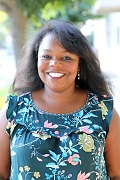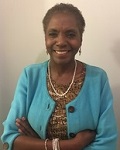Next Gen Navigator
Anti-Racism in the Middle School Science Classroom
By Rosanna Ayers, Yasmine Shakoor-Asadi, and Dr. Cheryl Talley
Posted on 2020-10-29
Disclaimer: The views expressed in this blog post are those of the author(s) and do not necessarily reflect the official position of the National Science Teaching Association (NSTA).
“Why do I not know about her?,” educators have asked. Why, as science educators with decades of combined experience, did we not know of Alice Ball’s contributions to science? In 1910, Alice Ball was the first woman to graduate with an MS degree in chemistry, and she developed the first successful treatment for leprosy, which became known as the “Ball Method.” Alice Ball was African-American, and therein lies the reason why her contributions to science have largely been excluded.
According to the author of White Fragility, sociologist Robin DiAngelo, America’s de facto segregated public schools produce ignorant people: ignorant white people when it comes to the contributions of African Americans. As a result of attending predominantly white schools, white students are racially isolated and therefore will attend mostly white colleges. Those who then choose to work in schools with predominantly black or brown students will tend to focus on their students’ learning needs while not ever realizing something may be lacking in their own knowledge base. This is particularly relevant in science and math education because students of color may not hear about a single scientist who wasn’t white, except for George Washington Carver. One reason for this is that their teachers don’t know of any.
The contributions of black and female scientists are effectively missing from curricula, which serves to reinforce bias in the science classroom through exclusion. When studying great thinkers in science endeavors, the deafening silence on Black achievements sends a clear message that African Americans have not been integral to science. But quite the opposite is true. African Americans have contributed to and led a great volume of scientific work that middle school students must be taught about this year in your science, English, and history classes.
The omissions of non-dominant peoples in the discussions of science are not accidental. We all have contributed and continue to contribute to systemic racism when we are not actively working against the exclusions of facts. Unearthing the contributions and stories of all who have contributed to science is one of the first steps to creating an anti-racist classroom.
Recently, much attention has been given to the racial inequities present in the criminal justice system. Yet the systemic and institutional forces supporting racist practices by police are also present in the way children of all races are educated, as DiAngelo points out in her book. This is unfortunate because the creativity, ingenuity, and tenacity demonstrated by Carver is present in the resilience demonstrated by many black and brown students who navigate under-resourced schools. However, few will come to realize that the ability to ask probing questions, solve problems imaginatively, and develop new, strange, but actually innovative ideas are what make a good scientist and a good science teacher.
An anti-racist science classroom is essential to the ability of the United States to become a 21st-century country, considering all the indicators of success including the education of its students and treatment of all its scientists.
As a person of color (POC) teaching a class of minority students, it is natural to seek out lessons and activities reflective of myself and the students in my classroom. For a white teacher teaching mostly white or all white students, this idea of teaching more than the colonized view of science may be more challenging. Growing up in the U.S. education system and then teaching in that system, we are taught exclusively about western European and white American scientists and inventors. The need to teach outside of this narrow view has always been there; the difference now is that teachers who are not POC have joined the effort to create a more just and accurate view of historical science and science in the modern era.
In the science classroom, an educator can plan a unit using resources outside of the curriculum that focus on scientists and inventors of color. While we acknowledge that we all have pacing guides and standards to follow, the inclusion is necessary and important. In the unit, educators can teach students about scientists and inventors that are outside of the norm, but should not be. Some examples include: the recognition and treatment of diabetes was developed in 2nd century BC in China, and the Tanzanian scientist and physicist Erasto B. Mpemba discovered the Mpemba effect, a paradoxical phenomenon in which hot water freezes faster than cold water under certain conditions. Teaching these lessons can ignite wonder in students and increase their global competency, both critical skills in achieving global citizenship.
Where do we go from here? How do we dismantle the systematic racism that has existed in science education for centuries and continues today? The best way to start this journey is to educate oneself on these issues. That may sound easy, but it’s often the most difficult work one can do. Reflection and self-awareness is key. We can no longer as a society pretend or act as if injustices do not exist because they do not affect us directly. They do, in fact, impact your students of color, greatly and deeply.
Resources to Support Your Anti-Racist Work
- Silence Is Never Neutral; Neither Is Science (blog post in Scientific American) https://blogs.scientificamerican.com/voices/silence-is-never-neutral-neither-is-science/
- “A Talk to Teachers,” article by James Baldwin. (originally published on October 16, 1963, in The Saturday Review)https://www.zinnedproject.org/materials/baldwin-talk-to-teachers
- Teaching About Race, Racism, and Police Violencehttps://www.tolerance.org/moment/racism-and-police-violence
- Colorlines, a BIPOC-led news site published by Race Forward, a national organization that advances racial justice through research, media, and practice https://www.colorlines.com/
- Neil DeGrasse Tyson on being black, and women in science https://www.youtube.com/watch?v=z7ihNLEDiuM
- Code Switch Podcasts: Co-hosts of color Gene Demby and Shereen Marisol Meraji discuss how race impacts everything in America. https://www.npr.org/podcasts/510312/codeswitch
- “Racism Is Killing the Planet,” an article in Sierra magazine that contends that the ideology of white supremacy leads the way toward disposable people and a disposable natural world. https://www.sierraclub.org/sierra/racism-killing-planet

Rosanna Ayers is the director of youth education at the Biomimicry Institute, overseeing the development of resources and programs to support educator interactions with the institute. Ayers served as the Region Lead for science education in six counties in her position as a county science coordinator. She has nearly 20 years of experience as a classroom educator, a college instructor, and a county office administrator for science. Ayers has a bachelor’s degree in International Business, a masters degree in Educational Leadership and School Development, and an administrative credential for K–12 education.

Yasmine Shakoor-Asadi teaches middle school science in Clover Park School District in Lakewood, Washington. She has worked with the Seattle Children’s Research institute developing curriculum for their mobile lab. She is also a member of her school district’s K–8 science leadership cadre, for which she has worked with The Institute of Systems Biology in Seattle. She was awarded a Fulbright Teachers for Global Classrooms Program Fellowship and looks forward to visiting Thailand in summer 2021.

Dr. Cheryl Talley, professor of neuroscience at Virginia State University, examines factors that lead to lasting behavioral change, specifically those related to high academic achievement. With her training in affective neuroscience, Talley uses various cognitive strategies, including mindfulness training, to help students develop strong academic identities and associated behaviors that last from kindergarten through grade 16.
Note: This article is featured in the October 2020 issue of Next Gen Navigator, a monthly e-newsletter from NSTA delivering information, insights, resources, and professional learning opportunities for science educators by science educators on the Next Generation Science Standards and three-dimensional instruction. Click here to sign up to receive the Navigator every month.
The mission of NSTA is to promote excellence and innovation in science teaching and learning for all.
Equity NGSS Professional Learning old Teacher Preparation Teaching Strategies Three-Dimensional Learning Middle School


